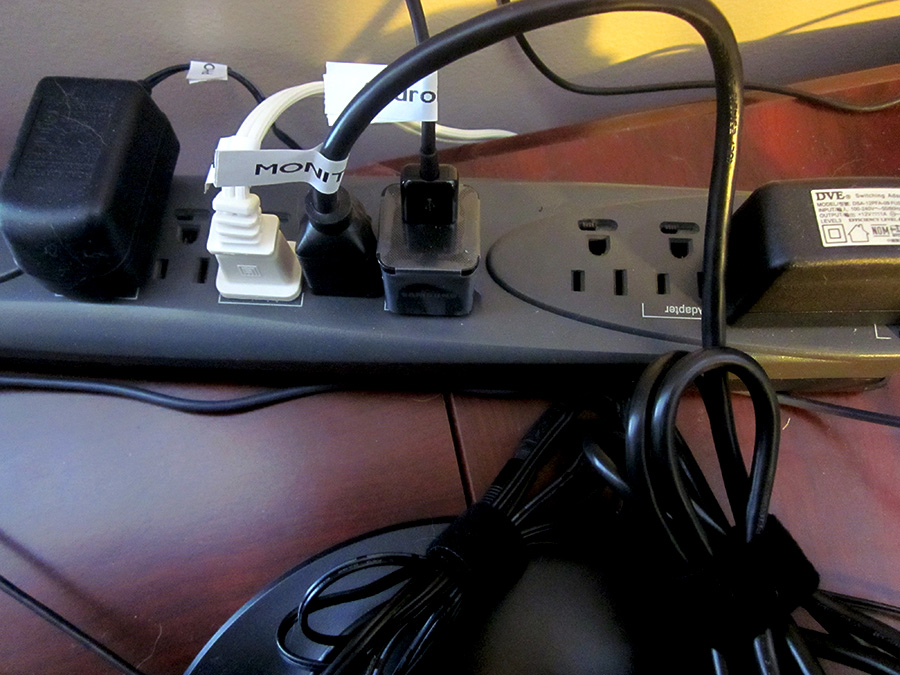This week’s segment in the Organized Life Series is concerned with organizing your hardware and cables. Over time, your media cabinet and computer area can get out of control. When you have to replace a piece of hardware it’s a nightmare of chasing cords to find out where the plug goes. No more! It’s time to take control.
Media Cabinet
In your one or more media cabinets you probably have several devices. You could have a TV, cable or satellite box, DVD or Bluray player, surround sound system, gaming system, media streaming box or more. You could also have a pile of old VHS or home movies sitting around. We’re going to address things in this order:
- Media – Get rid of stuff you don’t need. Digitize your home movies. Donate those VHS tapes you haven’t watched in years. Do the same with any games you don’t play.
- Hardware – Evaluate your needs. Get rid of stuff you aren’t using. Move things around if necessary. Buy new stuff if you need it and sell the old.
- Cables – Once everything is organized, label and organize your cables.
#1 – Media
Your media could be in the cabinet under your TV. It could be in a box somewhere. It could be on a bookshelf. Wherever it is, it’s time to consider it. Most of your video media has already been taken care in a previous week’s segment in the Organized Life Series on Video Media. There we discussed how to rip your DVDs to digital format and how to enjoy them as a part of a media system. But what about those old VHS tapes and home movies on various media?
Digitize your own home videos
(Information from Lifehacker – copied verbatim, including links.)
While analog audio enjoys a retro-resurgence, tapes are becoming a lost format in the video world. With many digital formats forgoing tapes entirely, it’s becoming more difficult to digitize your old media.
Tapes (VHS, Hi8, Etc.) Analog-to-digital video converters are the most common tools for digitizing your old tapes. In fact, your DV camera may have conversion capabilities. If you can input composite audio and video or s-video to your DV camera you can use it to digitize just about any analog source. All you’ll need to get it onto your computer is software that can handle a DV stream. Pretty much any video editing software made in the last decade can capture DV so you won’t be hard-pressed to find something. Apple’s iMovie and Final Cut Express/Pro (Mac), Windows Movie Maker (Windows), and Kino (Linux) are just a few examples. If you don’t have a DV Camera, you can also use TV Tuner cards with composite input or DV bridges made specifically for the purpose of converting analog video. For more information, Videohelp.org covers the analog-to-digital conversion process in greater detail.
While newer video recording formats tend to avoid or minimize the pitfalls of quality degradation through use, VHS tapes do not provide that luxury. You may find that when digitizing especially worn-out VHS tapes, the digital signal will cut out due to something as minor as a little jitter. This is due to a break in the timecode on the VHS tape. The simplest way around this issue is to obtain a high-quality, professional VHS deck with a time-base corrector. The time-base corrector will generate the timecode instead of the actual tape and this will prevent the jitter. While these decks were once fairly expensive, you can now find them used online for a fairly reasonable price.
Most analog video formats can be digitized by utilizing a converter, but in the case of Hi8 tapes you have another option. Sony created Digital8 camcorders that have the ability to digitize Hi8 tapes in-camera and output a DV signal.
Though the suggestion so far has been to save video in the DV codec, with enough video you’ll need a significant amount of disk space to store it. If you’re comfortable with more aggressive compression, encoding your newly digitized videos in MPEG4 or H.264 will help save a significant amount of space. Encoding at a data rate of around 2mbps and an audio data rate of 192kbps should provide you with a smaller file and a negligible loss of quality.
Get your home videos professionally digitized
There are dozens of companies out there providing this service from $10-$20 a tape, but many require you to ship your tapes to them. If you’re okay with putting your tapes in the mail, here are a couple websites to explore: Family Memories to DVD and The Photo Archival Co.. Be sure to give your local camera shop a call, too, because often they offer these services without having to ship and potentially lose your beloved home videos.
Once you have ripped all your DVDs and saved all your VHS and other home movies, have a look at what’s left. Old video games? Old CDs? Rip anything you can rip and get rid of the rest. If you’re not using it, sell it or donate it and get the tax write-off.
#2 – Hardware
While the goal of the Organized Life Series isn’t to spend money, now is a good time to evaluate your equipment. If you have the money, it’s a good time to replace things. Is your old Tube TV driving you nuts? Get a new one. If you’re an audiophile, it might be time to upgrade your surround sound system. Have you been thinking of dropping your cable company? Now might be a good time.
First, evaluate your system. Is there something that drives you crazy? Do you hate your layout? Rearrange your furniture. Do you hate that there is only 1 seat in the house that has a good view of the TV because it looks horrible from the side? Get a new TV. You might be amazed at the prices of TVs these days. Have a look at Amazon’s TVs, for example. Do you want to get rid of cable and satellite for good? It’s unlikely that you will have to miss any of your must-watch shows, though sports could be a problem. Keep that in mind.
Second, consider component locations. With today’s electronics, heat in your cabinet can be a real problem. Make sure there is plenty of air flow between your components. Also consider whether your remotes work where they need to. Does a cabinet door trim block your remote when you’re in your favorite chair? Will you have to hold up your remote in the air to turn on your TV?
Next, do you need a “Super-Remote”? If you have a lot of components, or 2 users that often have to chase down remotes, you might want to consider getting a Universal Remote like the Logitech Harmony One. I purchased this remote after doing a lot of research. Make sure you scroll down to the Logitech comparison chart to see the different Harmony remotes.
#3 – Cables
It’s time to chase those cables. Follow each cable and label it. You can purchase a lot of solutions for this, but I have used 2 solutions. #1 – Use those blank address labels you can buy for your printer. (Like these.) Hand write on these with a sharpie. Or #2 – use a label maker. I can’t tell you how much I’ve used my Dymo Letra Tag. Just print the label with some extra spaces so you can stick the labels around the cord.
After labeling your cables, tighten up any loose cords. There are tons of solutions for this that you can purchase, but here’s my favorite:
Get a huge roll of Velcro Cable Tie and do it yourself. I like the roll because you can cut strips in any length that you need. You can also use binder clips that you have laying around or old twist-ties. Here’s what it looks like when you’re done:
Computer Area
You may have several computers, but you probably have a general area like your office where you store things. You could have computers in use, old computers, old hard drives, old software disks, old manuals, old cameras, mice, mobile phones, and much, much more.. We’re going to address things in this order:
- Media – Gather all of your software disks, manuals, recovery DVDs, etc. Purge.
- Hardware – Evaluate your needs. Get rid of stuff you aren’t using safely. Move things around if necessary. Buy new stuff if you need it and sell or donate the old.
- Cables – Once everything is organized, label and organize your cables.
#1 – Media
Some of this will be obvious – you don’t need those 3 Quicken disks when you don’t even use Quicken anymore. Some things you know you need to keep – the disks for software that you have purchased that have access keys. You need to keep the papers and any system disks that came with your current computers. Place any for old computers with those old computers. What about your printer driver disk? Camera driver disks?
Sort all of your media into 4 piles:
- Old – to be donated or sold
- Trash – things nobody wants
- Important – keep and store properly
- Unknown – you’ll need to look into these a little further. For example, my printer driver disk comes with OCR software that I found later that I needed to install. But when I bought the printer I installed the latest firmware and drivers from the website, not the disk.
#2 – Hardware
First, evaluate your current hardware. Do you need to upgrade? I recently purchased a new desktop from the Dell Outlet for $300 to replace my poor, old, dying one that I had owned for over 5 years. (I tend to keep nice, new laptops and let my desktops age.) I’m not going to get into any brand comparison or anything. I just wanted to share how I feel like I got a good deal. (Side note: by watching this site, I found that Sunday morning seemed to be the best time to buy.) Regardless, if you really need to update your system, or can afford to get something nice, now is a good time to do it. Also consider whether your wireless router can handle all of your wireless devices. Think about getting a NAS system.
Second, consider component locations. With today’s electronics, heat in your cabinet can be a real problem. Make sure there is plenty of air flow between your components. Make sure your router is in the best place to service all the rooms in your house. Is your computer facing a window with distractions? Consider moving it.
Third, prepare your hardware for selling or donating. You probably have old computers, cameras, cell phones or other devices you don’t use anymore. For any of these devices, make sure they work, include any boxes and manuals that you can, and shine them up a little. (Get your kids’ cruddy fingerprints off them and such.) For phones and computers, you want to make sure you wipe any personal data and reset them to factory settings. Here are some great links:
- How do I securely wipe my computer?
- How to Properly Clean All Your Gadgets Without Ruining Them
- How to Securely Wipe Your Data from Any Phone on Any Platform
#3 – Cables
There’s basically no difference between organizing your cables for your media cabinet and your computer area except you might want to label both ends of some of the cables.
Selling and Donating Old Items
You can do this as you go or wait until all of our Weekly Organization is complete. Check out the Selling and Donating Old Items article for more details.






